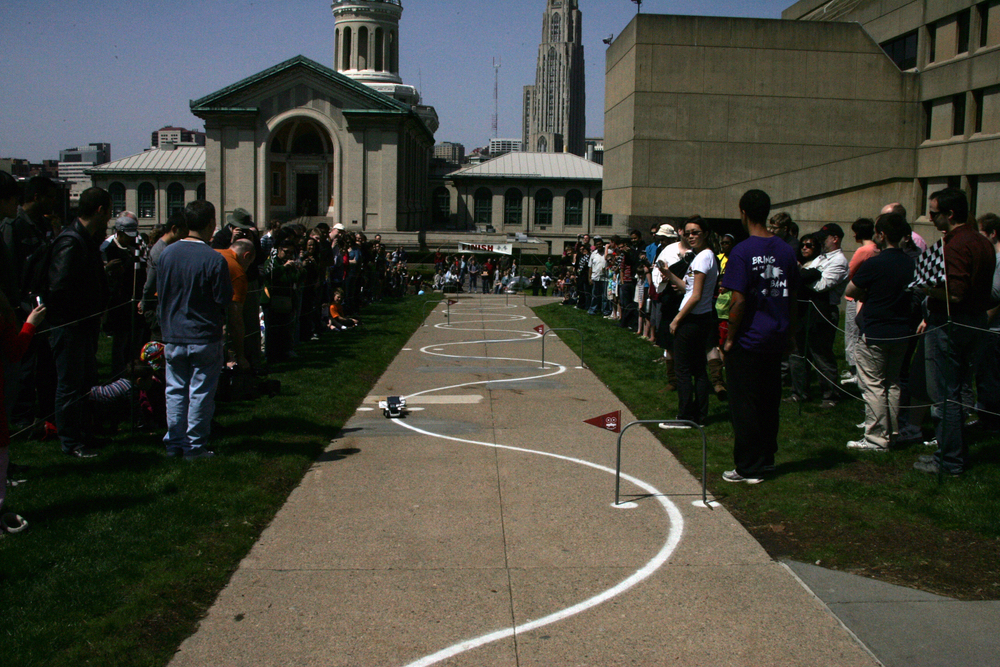MoBot Turns 25 A Quarter Century of the Little Mobile Robots That (Mostly) Could
Cara Gillotti (DC 2006)Tuesday, April 9, 2019Print this page.

Other Spring Carnival events might receive more hoopla. Buggy and Booth participants likely spend more time preparing for and working on them. But MObile roBOTs (commonly called "Mobot") enthusiasts don't seem to mind.
"Most people are focused on school and exams," said John Palmisano (CS 2004), a mechanical engineer who won the competition multiple times. "If people sleep the night before, it usually means they gave up."
For the participants and crowds — yes, crowds — that line the sidewalk in front of Wean Hall where, for the past 25 years, the Mobot Slalom Race has taken place, it's an unmissable event. Neither rain, nor snow, nor high winds keep the Mobot faithful from watching these autonomous robots crawl along the wavy white-lined course in a quest to see which one clears its 14 gates first. Lucky for recent competitors, the walkway where the race occurs received a much-needed paving a year and a half ago.
"Prior to that it was a mess, with patches and discoloration that made using sensor-based technology challenging," said Catherine Copetas, assistant dean for Industrial Relations and director of special events.
The track forks at the lower part of the course, called decision points, and the mobots need to choose the correct path if they're going to finish the race successfully. Mobots are judged on their ability to navigate sequentially through the gates, and each run is limited to four minutes. There are first-, second-, and third-place cash prizes awarded to undergraduates; an open class for alumni, staff and anyone who wants to participate; and the Ben Brown Judges' Choice Prize, for creativity, good show or anything else the judges want to recognize.
The course record, set in 2009 in the Open Class division by former CMU researcher Michael Licitra and Jeff McMahill (CS 1994), made it through Gate 14 in 00:33.99. (You can watch it from both the human and the mobot perspective.)
Mobot traces its roots to a Computer Science Department meeting in 1994, when professor and founding father of computer chess Hans Berliner (CS 1974) voiced his belief that the university should pay more attention to what students were doing. He really wanted to get them more excited about what they could do, especially in the relatively new field of robotics and especially autonomous robots.
The ensuing theme after the meeting: why not have a competition?
"I think he had the feeling that when Spring Carnival comes around, everyone talks about the buggy races. We should have something that's more on the science and engineering side that would let people get involved and didn't require a fraternity or other large organization," said Ben Brown, a Robotics Institute project scientist who has been involved with Mobot since the beginning. "So he came up with the idea of the Mobot Slalom Race."
The idea was so well-received that Lockheed Martin has been a sponsor since day one, and Boeing for almost as long, according to Copetas, who noted that General Motors has also long been a sponsor. "Hans designed the logo, which is still used today," she said.
A post-race debriefing known as the "15th Gate," held some days after the competition, allows Mobot participants to discuss what worked, what didn't and why.
"That's a great part about Carnegie Mellon," Copetas said. "It's not a big secret how you did something."
"It's a different challenge today," Brown said. "There's software that takes away the challenge of doing the low-level electronics that a lot of the early ones required. Dan Bothell won the first competition, and I think he took some pride that his didn't have an onboard computer — it was all analog electronics."
Through all the changes over the years, the students never fail to provide innovative solutions to the tricky problems that arise. And as one might expect, the look of mobots through the years has also run the gamut.
"There have been some very clunky ones, put a laptop on top of something and run it," Brown said. "There have been some interesting things that've happened when weather was bad. People would cover them up with boxes and things to keep the rain off. One was a fan-propeller-driven, swamp-boat thing, and there were a couple walking robots."
One year, students — pointing out that there wasn't a "no mammal" rule — used tuna to train a mouse to run the race. Never having seen grass before, the mouse ran over to it at the earliest opportunity. "In a controlled environment, the mouse was very successful!" Copetas said. The event triggered the institution of an actual "no mammal" rule.
Trained mice aside, the most remarkable aspect of Mobot may be its longevity. Despite advances in technology and robotics, it's still not an easy competition. "Students still have to work at it, 25 years later," Copetas said. "It's still a good idea."
Here's to another 25 years.
This year's Mobot Races will take place at noon on Friday, April 12, outside Wean Hall.
Byron Spice | 412-268-9068 | bspice@cs.cmu.edu
